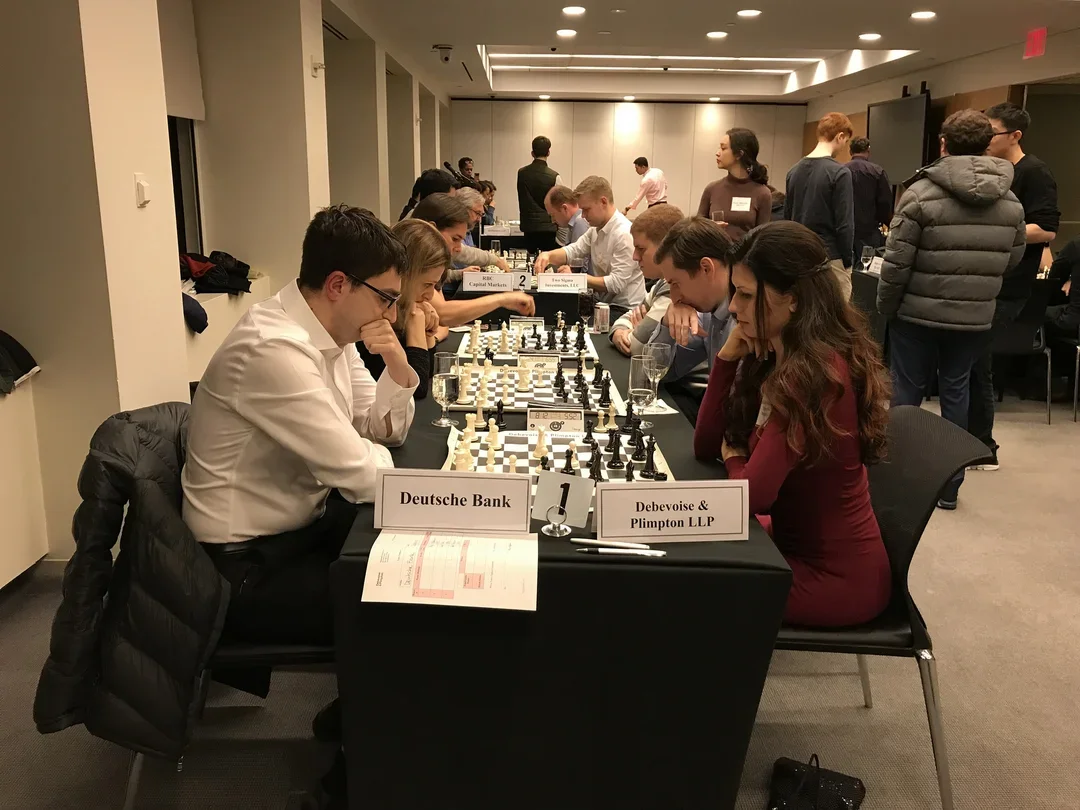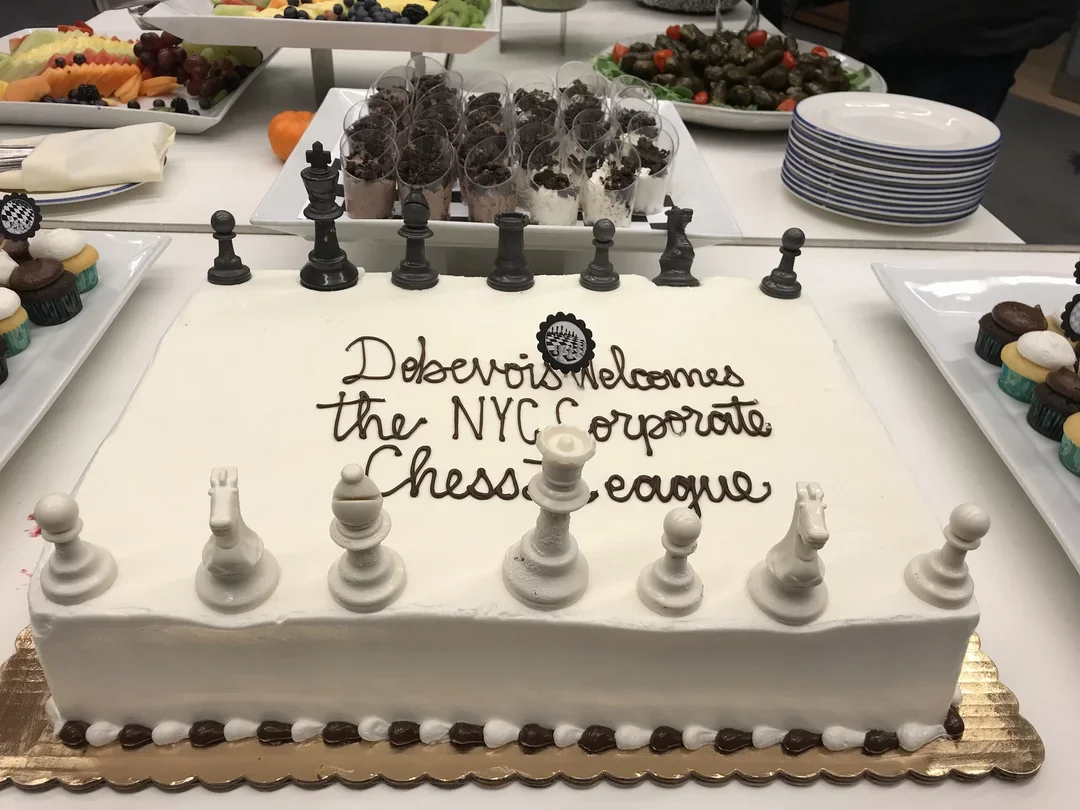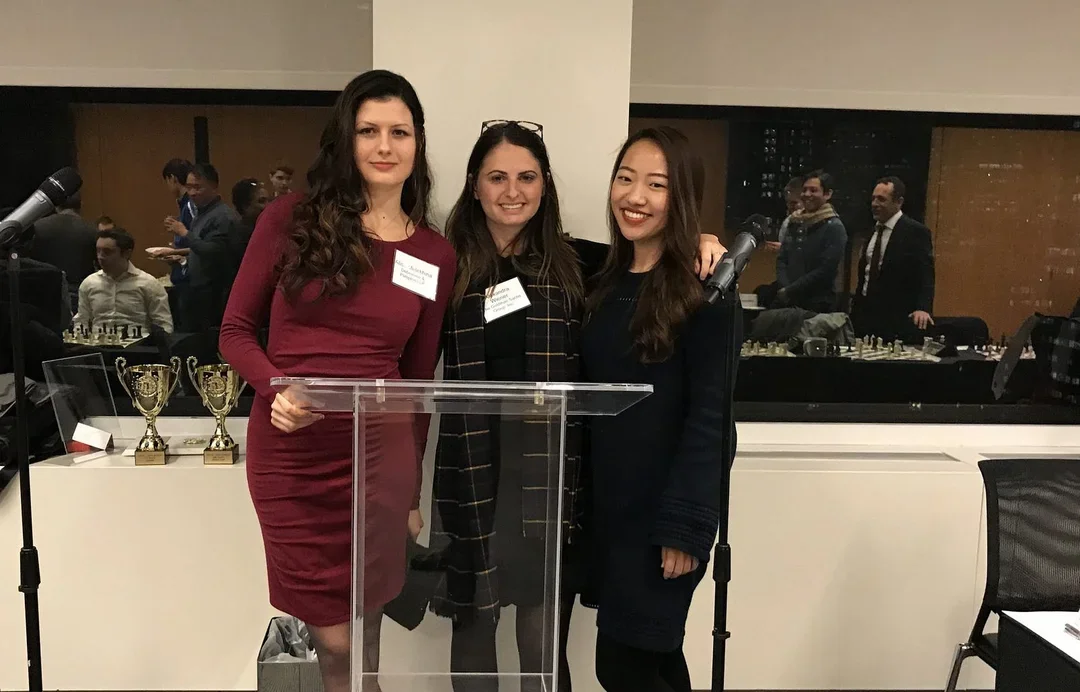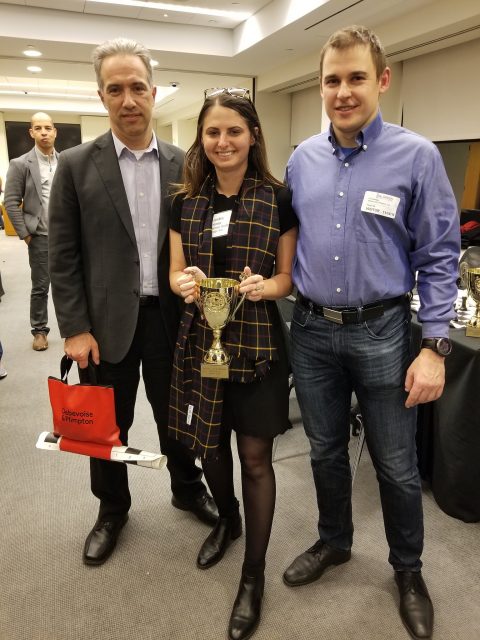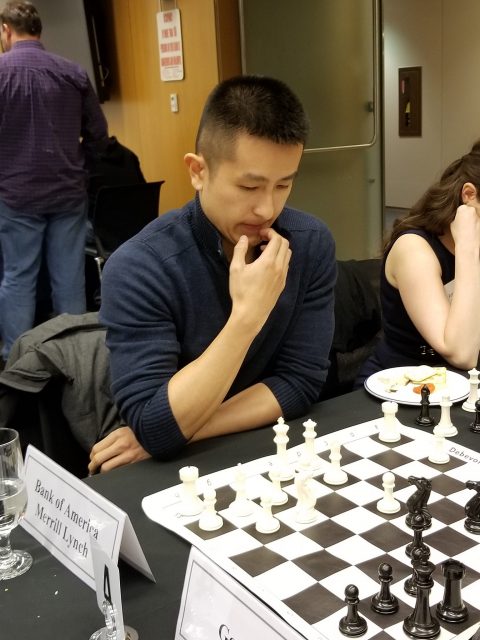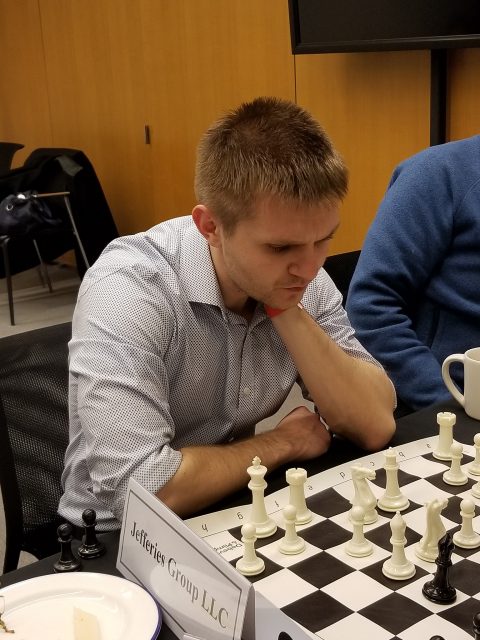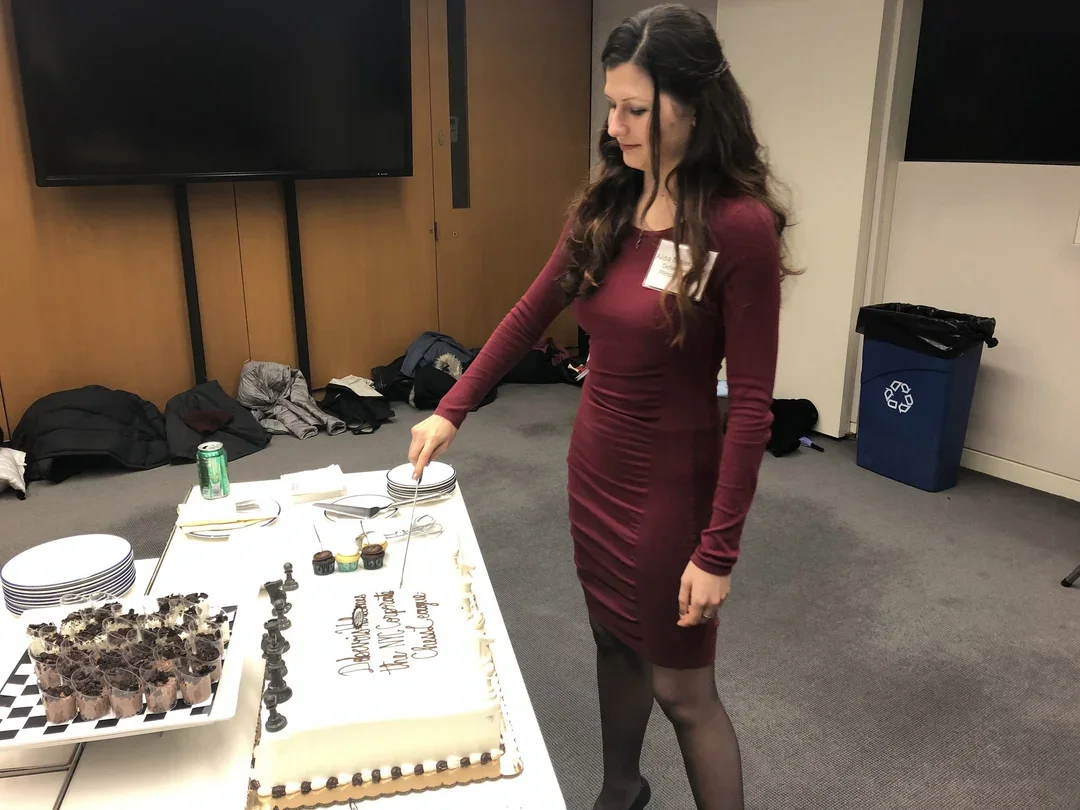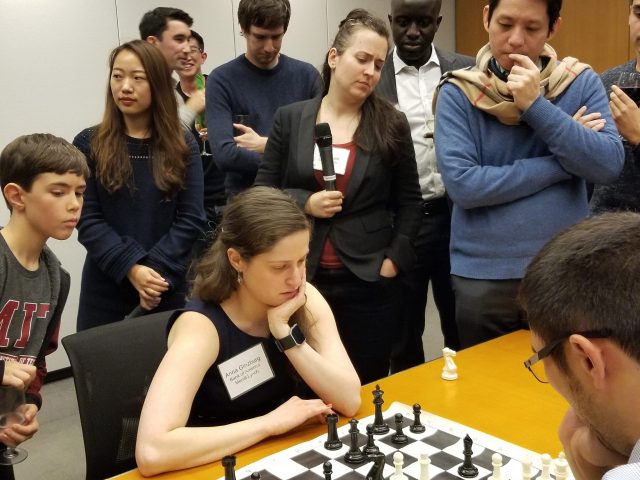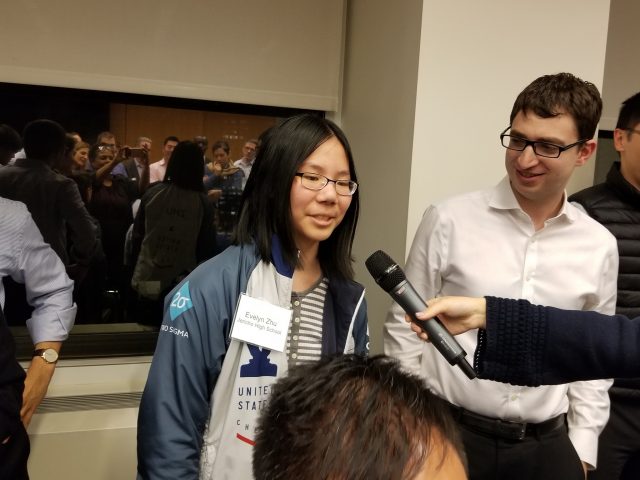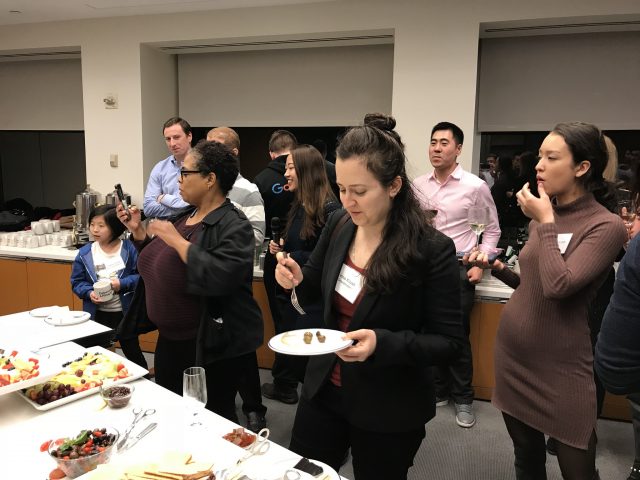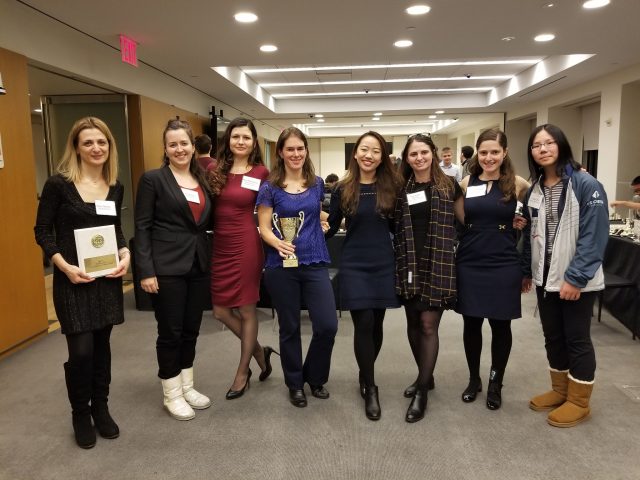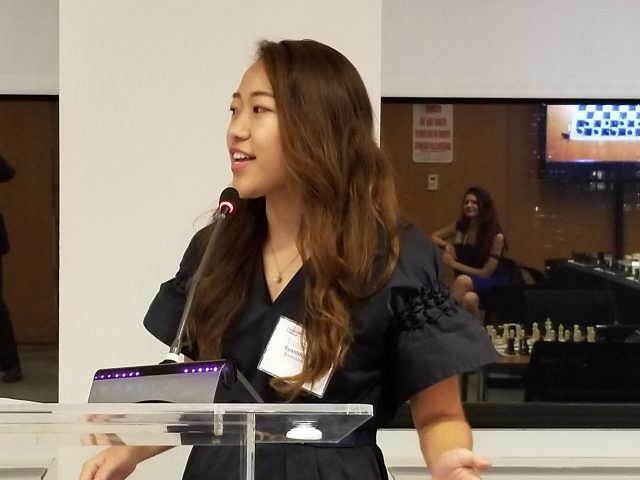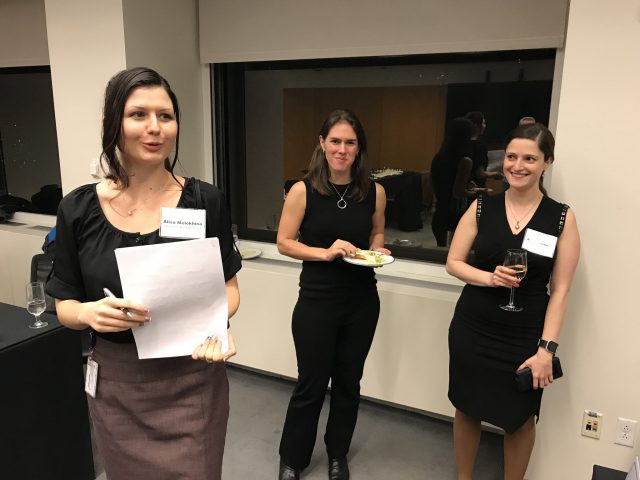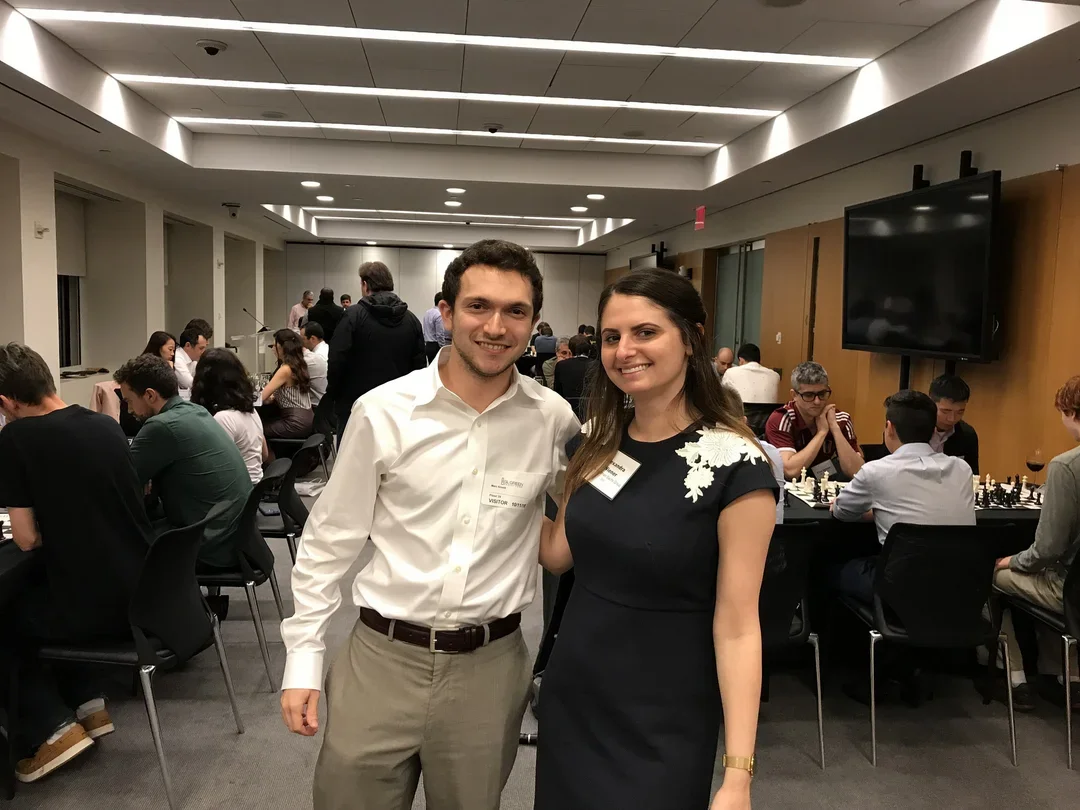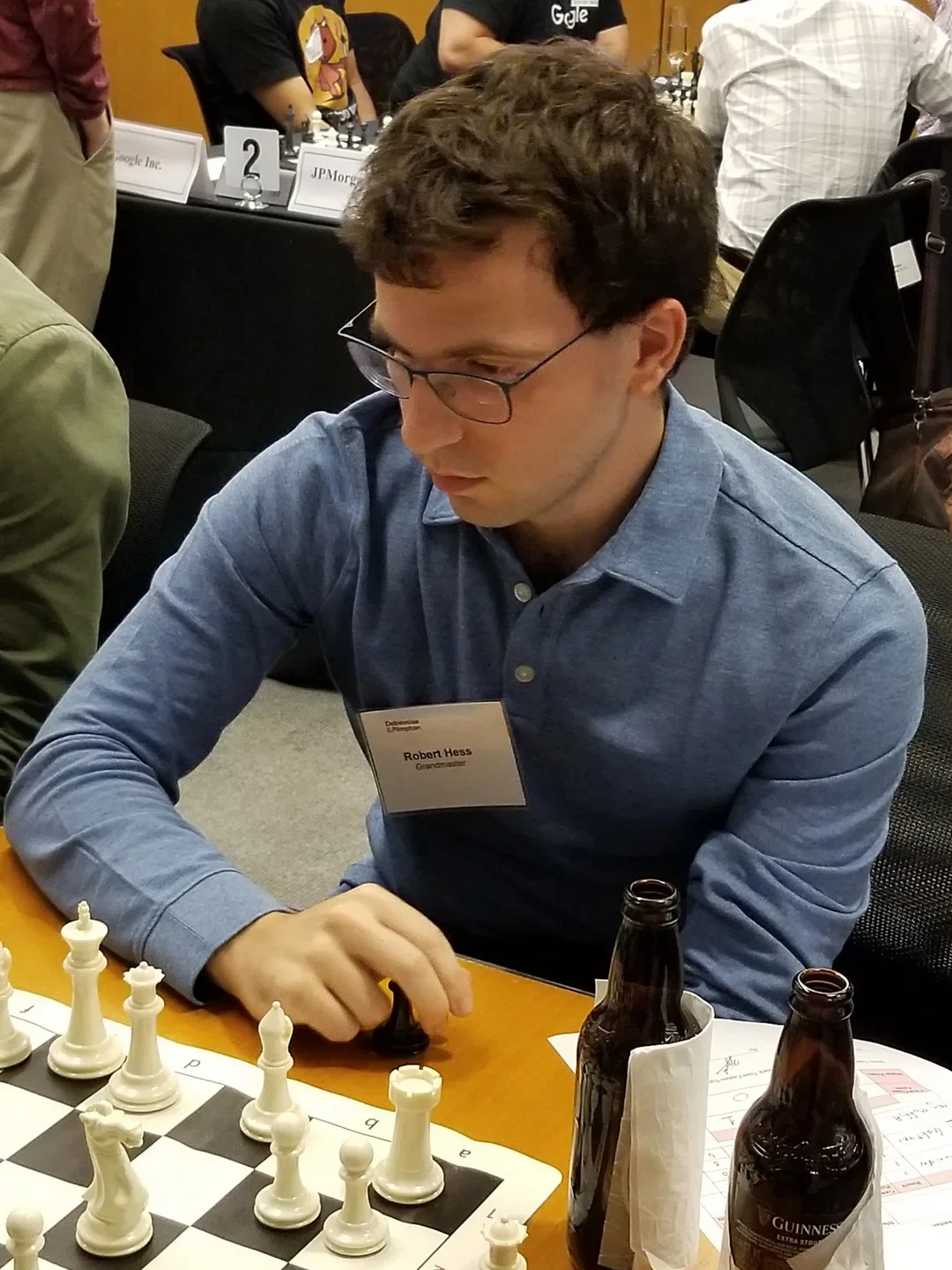FM Alisa Melekhina shares insights in her capacity as a co-organizer and board 1 player in the inaugural season of the NYCCL.
After six matches spanning two months, the inaugural (2018) season of the New York City Corporate Chess League (“NYCCL”) concluded on November 15. In the final match, Deutsche Bank beat home team Debevoise & Plimpton LLP on board 1, securing a perfect 6/6 score for a first-place finish.
RBC Capital Markets, led by team captain FM Kyron Griffith, finished in second place with 4.5/6 after drawing with Two Sigma in the final match.
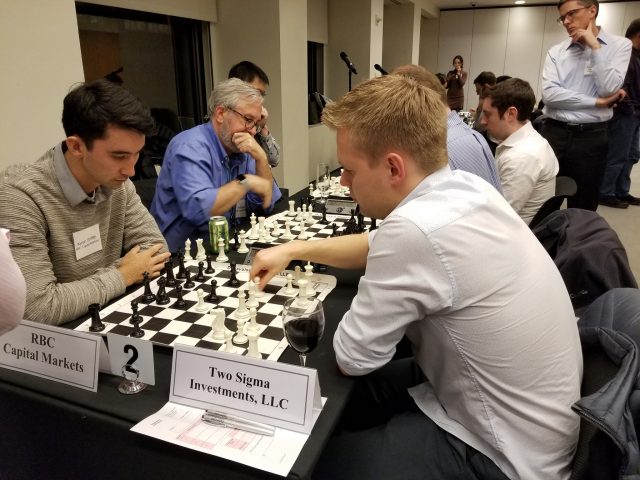
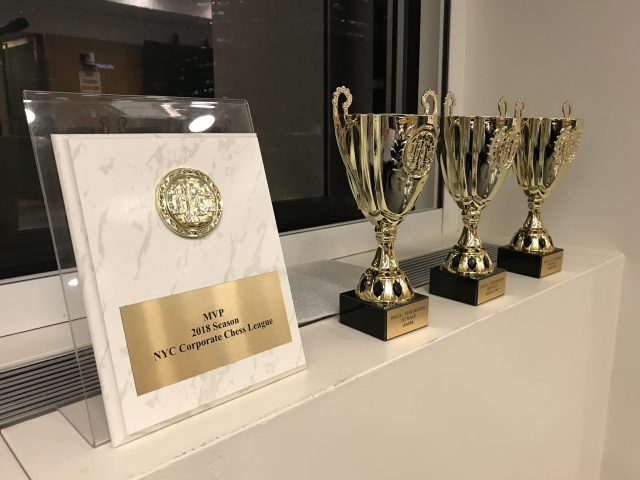 The top three teams each received a cup and a Debevoise chess set used during the season. The cups have the following tiers. First: Leader; Second: Trailblazer; Third: Rising Star.
Bank of America Merrill Lynch led by board 1 IM Victor Shen and Two Sigma (sponsors of the U.S. Chess World Youth and Cadet teams) also finished with 3.5/6 points in the three-way tie for third, but based on tiebreaks finished in fourth and fifth place, respectively.
The Deutsche Bank team had been a powerhouse throughout the season, stacked with internationally ranked masters and national team veterans. FM Igor Shneider led the charge on board 1, while boards 2 and 3 fielded former U.S. Women’s Championships: IM Rusudan (“Rusa”) Goletiani on board 2, and WIM Elina Cotler (née Groberman) on board 3. Goletiani finished as the NYCCL MVP, scoring 11/12 points throughout the season.
The top three teams each received a cup and a Debevoise chess set used during the season. The cups have the following tiers. First: Leader; Second: Trailblazer; Third: Rising Star.
Bank of America Merrill Lynch led by board 1 IM Victor Shen and Two Sigma (sponsors of the U.S. Chess World Youth and Cadet teams) also finished with 3.5/6 points in the three-way tie for third, but based on tiebreaks finished in fourth and fifth place, respectively.
The Deutsche Bank team had been a powerhouse throughout the season, stacked with internationally ranked masters and national team veterans. FM Igor Shneider led the charge on board 1, while boards 2 and 3 fielded former U.S. Women’s Championships: IM Rusudan (“Rusa”) Goletiani on board 2, and WIM Elina Cotler (née Groberman) on board 3. Goletiani finished as the NYCCL MVP, scoring 11/12 points throughout the season.
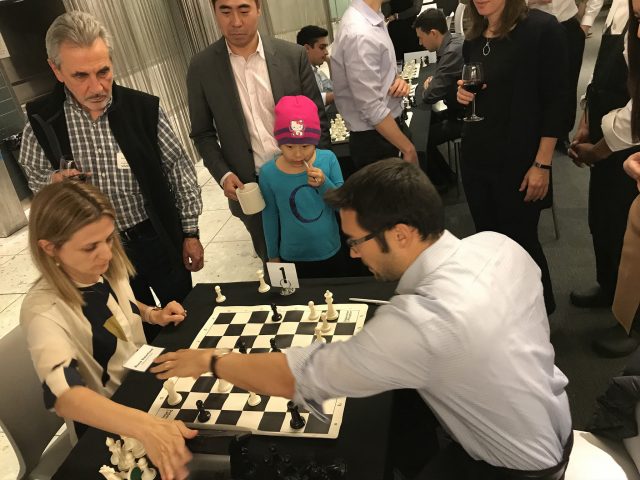 Asuka Nakamura faces off against Goletiani in a bullet (1 min) game during a bullet side tournament held after match 4.
Cotler was the MVP runner up, scoring 8.5 points throughout the season. She says of this win against the French in the round 3: “I found the tactic [and] it felt good to see it as I was very rusty. With the d and e pawns I won fairly quickly.”
Asuka Nakamura faces off against Goletiani in a bullet (1 min) game during a bullet side tournament held after match 4.
Cotler was the MVP runner up, scoring 8.5 points throughout the season. She says of this win against the French in the round 3: “I found the tactic [and] it felt good to see it as I was very rusty. With the d and e pawns I won fairly quickly.”
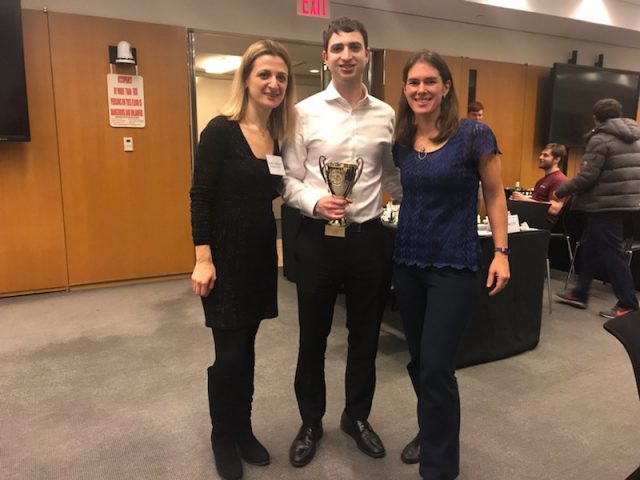 Shneider, Cotler, and Goletiani accepting the “Leader Cup” for Deutsche Bank’s first place finish, along with awards for their MVP performances
After the final match concluded, the closing ceremony festivities kicked off with the cutting of the chess cake.
Complementing the GM blindfold simul conducted by GM Robert Hess at the opening ceremony, the closing ceremony featured a GM tandem exhibition match. Grandmasters Marc Arnold and Vladimir Romanenko each led teams a la the Ultimate Moves showdowns popularized by Chess Club and Scholastic Center of St. Louis. GM Irina Krush, who arrived back to NYC just a few days after playing in the Women’s World Championships in Khanty Mansiysk, Russia, served as a commentator along with co-organizer WIM Yuanling Yuan. Yuanling oversaw the various side events throughout the season, such as the popular bullet and tandem tournaments.
Shneider, Cotler, and Goletiani accepting the “Leader Cup” for Deutsche Bank’s first place finish, along with awards for their MVP performances
After the final match concluded, the closing ceremony festivities kicked off with the cutting of the chess cake.
Complementing the GM blindfold simul conducted by GM Robert Hess at the opening ceremony, the closing ceremony featured a GM tandem exhibition match. Grandmasters Marc Arnold and Vladimir Romanenko each led teams a la the Ultimate Moves showdowns popularized by Chess Club and Scholastic Center of St. Louis. GM Irina Krush, who arrived back to NYC just a few days after playing in the Women’s World Championships in Khanty Mansiysk, Russia, served as a commentator along with co-organizer WIM Yuanling Yuan. Yuanling oversaw the various side events throughout the season, such as the popular bullet and tandem tournaments.
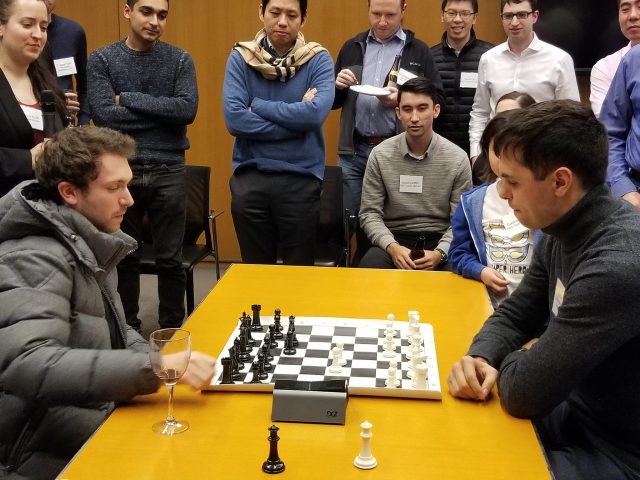 GMs Arnold and Romanenko begin the games. Romanenko’s new venture is USAchesstour.com, organizing chess tournaments in the NY area.
The season imparted more than just chess lessons. It was an organizational marathon. But as with all marathons, there is nothing quite like the satisfaction of crossing the finish line.
The Planning Stage
The first season of the NYCCL intended to serve as a pilot to meet an overlooked need of the NYC corporate and chess communities. While the season exceeded our expectations all around, it also took more than expected to pull it off.
As chess players, we tend to have blinders on when it comes to tournaments. Our task is to execute over the board. We might complain about the timeliness or accuracy of pairings, but don’t usually pay attention the work that goes on behind the scenes. I had a glimpse into this organizational world, only from the outside perspective as a participant. I’ve seen everything from the local weekend quad, to massive scale open tournaments by the Continental Chess Association, to the luxurious conditions at Millionaire Chess, the World Team Championships in China, and U.S. Championships at the Chess Club & Scholastic Center of St. Louis. When first contemplating the NYCCL, our three-person organizational team barely knew what we were getting ourselves into.
“We have enough chess enthusiasts at our firms to form a team — why don’t we organize a match!?” In early 2018, my longtime friend WIM Yuanling Yuan and I were catching up over our latest trials and tribulations at our corporate jobs in NYC —mine as an attorney at Debevoise & Plimpton LLP, Yuanling’s as an Analyst at Blackstone. Naturally, the topic shifted to keeping up with chess, which depends in large part on internal support at our employers. We each knew (casual) players at our firms, and semi-professional players like ourselves at other institutions around the city. A strictly corporate chess league seemed like an obvious outlet. Why wasn’t one already around?
Not long after our musings, we looped in mutual friend Alexandra (“Alex”) Wiener, Analyst at Goldman Sachs, who had similar thoughts with respect to organizing the multitude of chess enthusiasts at Goldman Sachs. The NYCCL was born. Like Alex, we all knew a “corporate league was necessary, but someone needed to be the first mover.”
Execution
Like all ideas, it was nice in theory, but what next? Other than the members and structure, we needed a space and supplies. A major obstacle in working with corporate teams is navigating the internal compliance requirements of each firm. Many of our contacts were at large banks in the city. As much as one of them would like to host the chess league, any external donations, sponsorships, and PR are subject to strict, internal approvals. The NYCCL was almost caught in compliance limbo without ever coming to fruition.
Yuanling recalls, “We had the concept, the know-how, and even the audience. Yet, organizing the venue was one of the greatest challenges of implementing the NYCCL.”
I’ll spare the readers the details and will fast forward several months when we were finally able to secure the generous hosting capabilities of Debevoise & Plimpton LLP, where I currently practice as a fifth-year litigation associate.
Format
With the NYCCL players being full-time corporate professionals, we needed to have a league format that was respectful of everyone’s non-chess commitments while still providing a competitive atmosphere. We considered the timing and extent of matches. Playing matches on a bi-weekly Thursday evening schedule seemed to strike the right chord. Each team must field three players for each match, and can sub in players as needed. Indeed, that was the most frequent request as many players had conflicting work obligations.
We initially estimated between 8-12 teams competing, and at first considered a round robin format where each team would play every other team. However, once we confirmed the line-up and learned more about the potential expenses of hosting a match each week, we decided on a mid-way point of six total matches; the opening and closing ceremonies would accompany the first and final matches, respectively.
An important difference between the NYCCL and other leagues is our strict approach to the composition of a team. A team must be comprised of three players all employed in some capacity by the same private entity.
This requirement leads to several benefits. It evens the playing field by eliminating the prospect of strong sit-in players unrelated to the core team. More significantly, it reinforces the identities of the teams, which leads to internal support. Ideally, the NYCCL would never need to charge any type of entry fees or contributions from the players; it would be sponsored by interested companies.
The games are unrated and there are no monetary prizes at stake. The players participate due to an almost-forget motivation: the love of the game! (And occasionally, for pride.)
Having a shorter time control also seemed consistent with the goal of maintaining flexibility. The games were in a rapid G/10 + 3’d time control, with each board playing once with white and with black. We expected and encouraged spectator guests from the competing companies. To that end, a rapid time control would support opportunities for casual games before or after the matches. Everyone enjoyed dropping in and playing so much that when it came time to begin the official games, we were hesitant to break up the fun!
Playing
While we were primarily acting as organizers, that didn’t mean we didn’t take the games seriously as players. Yuanling and I were each playing as the first board for our respective teams. Along with Alex, we each separately arranged for training sessions for the players on our team to accustom them with tournament etiquette and offer tips for improvement.
Playing on the first board was an undertaking on its own. While the strengths of the second and third boards varied, the first board (usually the team captain) was at least a chess master for 8 out of the 12 teams. (As the NYCCL progressed and word spread, hidden masters from the companies surfaced and joined their team’s roster.) This created a healthy sense of competition among the top players.
GMs Arnold and Romanenko begin the games. Romanenko’s new venture is USAchesstour.com, organizing chess tournaments in the NY area.
The season imparted more than just chess lessons. It was an organizational marathon. But as with all marathons, there is nothing quite like the satisfaction of crossing the finish line.
The Planning Stage
The first season of the NYCCL intended to serve as a pilot to meet an overlooked need of the NYC corporate and chess communities. While the season exceeded our expectations all around, it also took more than expected to pull it off.
As chess players, we tend to have blinders on when it comes to tournaments. Our task is to execute over the board. We might complain about the timeliness or accuracy of pairings, but don’t usually pay attention the work that goes on behind the scenes. I had a glimpse into this organizational world, only from the outside perspective as a participant. I’ve seen everything from the local weekend quad, to massive scale open tournaments by the Continental Chess Association, to the luxurious conditions at Millionaire Chess, the World Team Championships in China, and U.S. Championships at the Chess Club & Scholastic Center of St. Louis. When first contemplating the NYCCL, our three-person organizational team barely knew what we were getting ourselves into.
“We have enough chess enthusiasts at our firms to form a team — why don’t we organize a match!?” In early 2018, my longtime friend WIM Yuanling Yuan and I were catching up over our latest trials and tribulations at our corporate jobs in NYC —mine as an attorney at Debevoise & Plimpton LLP, Yuanling’s as an Analyst at Blackstone. Naturally, the topic shifted to keeping up with chess, which depends in large part on internal support at our employers. We each knew (casual) players at our firms, and semi-professional players like ourselves at other institutions around the city. A strictly corporate chess league seemed like an obvious outlet. Why wasn’t one already around?
Not long after our musings, we looped in mutual friend Alexandra (“Alex”) Wiener, Analyst at Goldman Sachs, who had similar thoughts with respect to organizing the multitude of chess enthusiasts at Goldman Sachs. The NYCCL was born. Like Alex, we all knew a “corporate league was necessary, but someone needed to be the first mover.”
Execution
Like all ideas, it was nice in theory, but what next? Other than the members and structure, we needed a space and supplies. A major obstacle in working with corporate teams is navigating the internal compliance requirements of each firm. Many of our contacts were at large banks in the city. As much as one of them would like to host the chess league, any external donations, sponsorships, and PR are subject to strict, internal approvals. The NYCCL was almost caught in compliance limbo without ever coming to fruition.
Yuanling recalls, “We had the concept, the know-how, and even the audience. Yet, organizing the venue was one of the greatest challenges of implementing the NYCCL.”
I’ll spare the readers the details and will fast forward several months when we were finally able to secure the generous hosting capabilities of Debevoise & Plimpton LLP, where I currently practice as a fifth-year litigation associate.
Format
With the NYCCL players being full-time corporate professionals, we needed to have a league format that was respectful of everyone’s non-chess commitments while still providing a competitive atmosphere. We considered the timing and extent of matches. Playing matches on a bi-weekly Thursday evening schedule seemed to strike the right chord. Each team must field three players for each match, and can sub in players as needed. Indeed, that was the most frequent request as many players had conflicting work obligations.
We initially estimated between 8-12 teams competing, and at first considered a round robin format where each team would play every other team. However, once we confirmed the line-up and learned more about the potential expenses of hosting a match each week, we decided on a mid-way point of six total matches; the opening and closing ceremonies would accompany the first and final matches, respectively.
An important difference between the NYCCL and other leagues is our strict approach to the composition of a team. A team must be comprised of three players all employed in some capacity by the same private entity.
This requirement leads to several benefits. It evens the playing field by eliminating the prospect of strong sit-in players unrelated to the core team. More significantly, it reinforces the identities of the teams, which leads to internal support. Ideally, the NYCCL would never need to charge any type of entry fees or contributions from the players; it would be sponsored by interested companies.
The games are unrated and there are no monetary prizes at stake. The players participate due to an almost-forget motivation: the love of the game! (And occasionally, for pride.)
Having a shorter time control also seemed consistent with the goal of maintaining flexibility. The games were in a rapid G/10 + 3’d time control, with each board playing once with white and with black. We expected and encouraged spectator guests from the competing companies. To that end, a rapid time control would support opportunities for casual games before or after the matches. Everyone enjoyed dropping in and playing so much that when it came time to begin the official games, we were hesitant to break up the fun!
Playing
While we were primarily acting as organizers, that didn’t mean we didn’t take the games seriously as players. Yuanling and I were each playing as the first board for our respective teams. Along with Alex, we each separately arranged for training sessions for the players on our team to accustom them with tournament etiquette and offer tips for improvement.
Playing on the first board was an undertaking on its own. While the strengths of the second and third boards varied, the first board (usually the team captain) was at least a chess master for 8 out of the 12 teams. (As the NYCCL progressed and word spread, hidden masters from the companies surfaced and joined their team’s roster.) This created a healthy sense of competition among the top players.
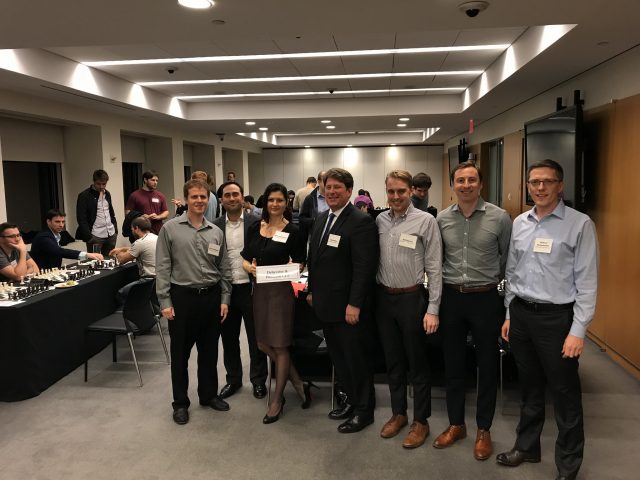 Full Debevoise chess team. From left to right: Ben Lee Friedman, Sebastian Ruiz, Alisa Melekhina, Matthew L. Biben, Bill Barlow, David Rock, Alex Romanovski
Thus, the organizers needed one reliable point of contact in the form of a team captain. In fact, when players from other companies ask how they can participate, that’s exactly how. There needs to be one team captain who can collect at least three chess players able to compete for each match. In practice, this means each team should have at least five or so chess players to account for absences and last-minute cancellations in order to field a full line-up each time. The chess players can be of any strength, but should at least know how to play chess and basic tournament etiquette.
Another critical responsibility for a team captain is to facilitate approval by the firm’s internal compliance and/or communications department to (1) participate in the league as a team and (2) be referred to in PR as a participating team. As chess players, we’re not accustomed to considering ourselves as representatives when playing, but this is an important procedural consideration when playing for a corporate team. The company might have conflicts with other participating teams or communications policies that need to be vetted before a representative team can be formed. This was the trickiest logistical obstacle to navigate — it took no less than three weeks to obtain approval from each participating team to be mentioned in the initial PR statement announcing the NYCCL.
Attention to Detail
Deciding the high-level organizational points is barely half of the work. As far as competitive pursuits go, chess requires a minimal amount of supplies. It’s as simple as having a chess set and showing up to play, right? Not when it comes to combining chess with the level of organization and attention to detail inherent in corporate culture. To provide an idea of the various (unexpected) issues that needed to be addressed, below is a non-exhaustive list:
Communications
Full Debevoise chess team. From left to right: Ben Lee Friedman, Sebastian Ruiz, Alisa Melekhina, Matthew L. Biben, Bill Barlow, David Rock, Alex Romanovski
Thus, the organizers needed one reliable point of contact in the form of a team captain. In fact, when players from other companies ask how they can participate, that’s exactly how. There needs to be one team captain who can collect at least three chess players able to compete for each match. In practice, this means each team should have at least five or so chess players to account for absences and last-minute cancellations in order to field a full line-up each time. The chess players can be of any strength, but should at least know how to play chess and basic tournament etiquette.
Another critical responsibility for a team captain is to facilitate approval by the firm’s internal compliance and/or communications department to (1) participate in the league as a team and (2) be referred to in PR as a participating team. As chess players, we’re not accustomed to considering ourselves as representatives when playing, but this is an important procedural consideration when playing for a corporate team. The company might have conflicts with other participating teams or communications policies that need to be vetted before a representative team can be formed. This was the trickiest logistical obstacle to navigate — it took no less than three weeks to obtain approval from each participating team to be mentioned in the initial PR statement announcing the NYCCL.
Attention to Detail
Deciding the high-level organizational points is barely half of the work. As far as competitive pursuits go, chess requires a minimal amount of supplies. It’s as simple as having a chess set and showing up to play, right? Not when it comes to combining chess with the level of organization and attention to detail inherent in corporate culture. To provide an idea of the various (unexpected) issues that needed to be addressed, below is a non-exhaustive list:
Communications
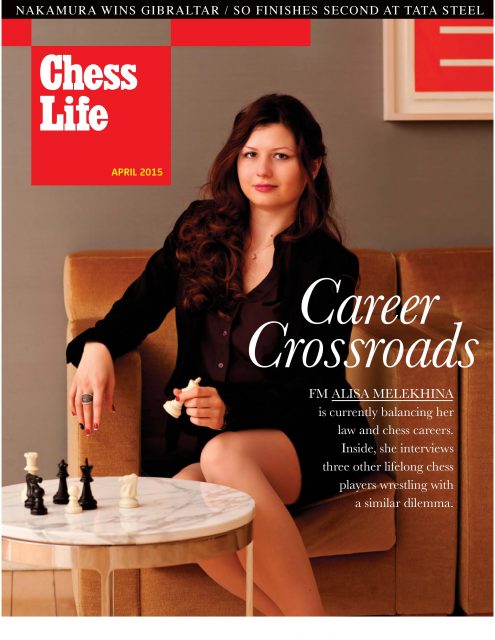 When not acting as the “clock guru,” Debevoise board three Alex Romanovski acted as a part-time photographer and provided indispensable support in tabulating the results, pairings, line-ups, and post-season survey. Noemi DeOleo took beautiful photos at the opening and closing ceremonies. It was a true team effort all around.
“The NYCCL was a whirlwind of an experience, but was extremely gratifying. We loved seeing how people from all walks of life come together on a bi-weekly basis for the love of chess. Everyone was always having a great time, beer in hand or not,” comments Yuanling. Alex agrees: “It was rewarding to interact with the players and spectators, who truly appreciated our efforts and encouraged us along the way. Many players and spectators even showed up early to help set up the pieces and stayed late to play casual games.”
The devil is in the details, especially when it comes to competitive play. I’m sure the issues are compounded for larger-scale tournaments and elite events; this experience certainly made me appreciate the effort that goes into hosting a tournament even more. Please make sure to personally thank the tournament organizer at your next event!
About the New York City Corporate Chess League
The NYCCL brings together chess players employed at various firms and corporations with offices in New York City. The league is comprised of three-player teams. Games are not rated, although players’ reported USCF and/or FIDE ratings are used for pairing purposes.
All players participate in their personal capacity, and must all be employed by the same private entity to form a team. Membership is currently by invitation only.
The 2018 season is hosted at the law offices of Debevoise & Plimpton LLP.
For more information, contact amelekhina@debevoise.com, yuanling.yuan@blackstone.com, and alexandra.wiener@gs.com.
FM Alisa Melekhina is a long-time competitor in US open tournaments and women’s national and world team invitational events. She graduated from the University of Pennsylvania Law school in May 2014 and is currently practicing as a corporate attorney in NYC. She previously wrote a popular CLO article on Balancing Law School and Chess.
When not acting as the “clock guru,” Debevoise board three Alex Romanovski acted as a part-time photographer and provided indispensable support in tabulating the results, pairings, line-ups, and post-season survey. Noemi DeOleo took beautiful photos at the opening and closing ceremonies. It was a true team effort all around.
“The NYCCL was a whirlwind of an experience, but was extremely gratifying. We loved seeing how people from all walks of life come together on a bi-weekly basis for the love of chess. Everyone was always having a great time, beer in hand or not,” comments Yuanling. Alex agrees: “It was rewarding to interact with the players and spectators, who truly appreciated our efforts and encouraged us along the way. Many players and spectators even showed up early to help set up the pieces and stayed late to play casual games.”
The devil is in the details, especially when it comes to competitive play. I’m sure the issues are compounded for larger-scale tournaments and elite events; this experience certainly made me appreciate the effort that goes into hosting a tournament even more. Please make sure to personally thank the tournament organizer at your next event!
About the New York City Corporate Chess League
The NYCCL brings together chess players employed at various firms and corporations with offices in New York City. The league is comprised of three-player teams. Games are not rated, although players’ reported USCF and/or FIDE ratings are used for pairing purposes.
All players participate in their personal capacity, and must all be employed by the same private entity to form a team. Membership is currently by invitation only.
The 2018 season is hosted at the law offices of Debevoise & Plimpton LLP.
For more information, contact amelekhina@debevoise.com, yuanling.yuan@blackstone.com, and alexandra.wiener@gs.com.
FM Alisa Melekhina is a long-time competitor in US open tournaments and women’s national and world team invitational events. She graduated from the University of Pennsylvania Law school in May 2014 and is currently practicing as a corporate attorney in NYC. She previously wrote a popular CLO article on Balancing Law School and Chess.

[pgn]
[Event "NYCCL Season 1"]
[Site "?"]
[Date "2018.11.15"]
[White "Dementiev, Aleksandr"]
[Black "Griffith, Kyron"]
[Result "0-1"]
[ECO "B92"]
[WhiteElo "1972"]
[BlackElo "2457"]
[PlyCount "44"]
[EventDate "2018.??.??"]
[WhiteTeam "Two Sigma"]
[BlackTeam "RBC Capital Markets"]
1. e4 c5 2. Nf3 d6 3. d4 cxd4 4. Nxd4 Nf6 5. Nc3 a6 6. Be2 e5 7. Nb3 Be7 8. Be3
O-O 9. f3 Be6 10. Qd2 Nbd7 11. Nd5 Nxd5 12. exd5 Bf5 13. Bd3 Bxd3 14. Qxd3 Rc8
15. O-O Bg5 16. f4 Bh6 17. Kh1 Qh4 18. Qf5 Rcd8 19. Rae1 g6 20. Qe4 Nf6 21. g3
Qxg3 $1 {This tactic came at the crucial last round on board 2 between RBC
Capital Markets and Two Sigma. Griffith brought home the win in this match-up
for his team after winning the pawn.} 22. hxg3 Nxe4 0-1[/pgn]
Goldman Sachs, led by co-organizer and team captain Alex Wiener, finished in third place after coming out ahead on tiebreaks based on total game points scored throughout the season.
 The top three teams each received a cup and a Debevoise chess set used during the season. The cups have the following tiers. First: Leader; Second: Trailblazer; Third: Rising Star.
The top three teams each received a cup and a Debevoise chess set used during the season. The cups have the following tiers. First: Leader; Second: Trailblazer; Third: Rising Star.[pgn]
[Event "NYCCL Season 1"]
[Site "?"]
[Date "2018.10.25"]
[White "Ansel, Andy"]
[Black "Goletiani, Rusa"]
[Result "0-1"]
[ECO "B21"]
[WhiteElo "1930"]
[BlackElo "2350"]
[PlyCount "20"]
[EventDate "2018.??.??"]
[WhiteTeam "RBC Capital Markets"]
[BlackTeam "Deutsche Bank"]
1. e4 c5 2. d4 cxd4 3. c3 d3 4. Bxd3 e6 5. c4 Nc6 6. Nf3 Qc7 7. Nc3 Nf6 8. O-O
Be7 9. Qe2 Ng4 10. h3 $2 Nd4 $1 {White must choose between giving up his queen
or checkmate on h2. He chose the third option of resigning.} 0-1[/pgn]
Cotler was among many other familiar faces in the chess world, such as Asuka Nakamura (JPMC) and Alex Pelekhaty (Jeffries), coming out of chess retirement to represent her team.
 Asuka Nakamura faces off against Goletiani in a bullet (1 min) game during a bullet side tournament held after match 4.
Asuka Nakamura faces off against Goletiani in a bullet (1 min) game during a bullet side tournament held after match 4.[pgn] [Event "NYCCL season 1"] [Site "?"] [Date "2018.10.11"] [White "Cotler, Elina"] [Black "Gramagin, Vladimir"] [Result "1-0"] [WhiteElo "2137"] [BlackElo "1846"] [SetUp "1"] [FEN "2rn2k1/pp1bqr1p/4p1p1/b2pP3/3P1PB1/P1N1B3/1P5P/2RQ1R1K w - - 0 22"] [PlyCount "5"] [EventDate "2018.??.??"] [WhiteTeam "Deutsche Bank"] [BlackTeam "Godman Sachs"] 22. Nxd5 $1 exd5 (22... Rxc1 $2 23. Nxe7+ Rxe7 24. Qxc1) 23. Rxc8 Bxc8 24. Bxc8 1-0[/pgn]
 Shneider, Cotler, and Goletiani accepting the “Leader Cup” for Deutsche Bank’s first place finish, along with awards for their MVP performances
Shneider, Cotler, and Goletiani accepting the “Leader Cup” for Deutsche Bank’s first place finish, along with awards for their MVP performances GMs Arnold and Romanenko begin the games. Romanenko’s new venture is USAchesstour.com, organizing chess tournaments in the NY area.
GMs Arnold and Romanenko begin the games. Romanenko’s new venture is USAchesstour.com, organizing chess tournaments in the NY area.[pgn]
[Event "NYCCL Season 1"]
[Site "?"]
[Date "2018.09.27"]
[White "Melekhina, Alisa"]
[Black "Griffith, Kyron"]
[Result "1-0"]
[ECO "B01"]
[WhiteElo "2295"]
[BlackElo "2457"]
[Annotator "Alisa Melekhina"]
[PlyCount "45"]
[EventDate "2018.??.??"]
[WhiteTeam "Debevoise "]
[BlackTeam "RBC Capital Markets"]
1. e4 d5 2. exd5 Qxd5 3. Nc3 Qd6 4. d4 Nf6 5. h3 a6 6. Nf3 b5 7. Be2 Bb7 8. O-O
e6 9. Ne5 c5 10. Bf3 $1 Nd5 11. Nxd5 Bxd5 12. Bf4 Qd8 13. c4 $1 $18 bxc4 14.
Qa4+ Nd7 15. Bxd5 exd5 16. Rfe1 (16. Nc6 {was also possible. I chose the game
move of Rfe1, because I find that these "quiet" moves in dangerous positions
-- especially when time is a factor -- tend to be more difficult for the
opponent to deal with than forcing moves.} Nb6) 16... Be7 17. Nc6 Qb6 (17...
Nb6 {an attempt to untangle, although White will nevertheless win a decisive
amount of material once the queen moves.}) 18. Rxe7+ Kf8 19. Rxd7 Qxb2 20. Re1
cxd4 21. Bd6+ Kg8 22. Ne7+ Kf8 23. Nc8+ {Revealing two options for mate (Rd8#
or Re8#) once the black king is forced to move to g8.} 1-0[/pgn]
Team Captain Model
The team captain model is critical to the execution of the NYCCL. Each team has a designated team captain; the default team captain was the organizers’ first line of contact from each company — usually a fellow chess player from back in the day that now happened to work at one of the companies in the city.
The team captains are responsible for gathering players for each match and passing on updates to their members. Because the team line-ups change for each match, it would not have been feasible for us to be in touch (especially at the risk of spamming) all possible players.
 Full Debevoise chess team. From left to right: Ben Lee Friedman, Sebastian Ruiz, Alisa Melekhina, Matthew L. Biben, Bill Barlow, David Rock, Alex Romanovski
Full Debevoise chess team. From left to right: Ben Lee Friedman, Sebastian Ruiz, Alisa Melekhina, Matthew L. Biben, Bill Barlow, David Rock, Alex Romanovski- Designing and drafting invitation text
- Revising standard corporate attendance registration template to support chess team line-up input
- Registering guests with building security
- Coordinating with team captains to ensure all interested players are informed
- Calculating team rating averages when many players do not have official ratings
- Overseeing line-up cancellations and substitutions
- Updating security and attendee list with new guests for each match
- Arranging ceremony programming and side events
- Arranging for photographs
- Uploading and sharing photographs
- Drafting PR and social media updates
- Designing and analyzing post-season survey
- Designing customized chess boards (thank you House of Staunton!)
- Ordering chess sets and clocks
- Selecting tables with proper length and width to accommodate three chess boards (standard boardroom tables in conference rooms are too wide to accommodate opponents sitting across from each other)
- Setting up podium, featured table, and six rows of chess tables for each match (and moving them out the next morning as our designated conference room space is used for other events)
- Storing chess sets and ensuring they are all properly unpacked and packed before/after matches
- Setting up chess pieces before each match
- Ensuring all clocks are set to time control (learning how to set the clock was its own challenge!)
- Arranging for room technology needs (e.g. microphones, screens & projectors to broadcast simul)
- Designing team name-cards and table number-cards
- Maintaining player nametags upon reception check-in
- Ordering food and refreshments
- Setting up catering, utensils, glasses, mugs, etc.
- Cleaning up used plates, cups, and trash after matches
- Arranging for a guest tournament director each match (the organizers usually play and cannot officiate disputes)
- Deciding on touch-move and illegal move rules
- Deciding on extent of involvement of team captains during play (can only advise on taking draw offers)
- Managing noise levels when official games are still in progress (read: shushing players analyzing too loudly when finished)
- Recording team line-up updates from week-to-week
- Printing table scorecards
- Setting pens at each table so captains can fill in scorecards
- Checking results were properly entered on scorecards (before players got used to the scorecard system, there was confusion over inputting individual game points from the double-matches and tabulating the overall match point)
- Scanning scorecards into records
- Creating and maintaining team result pairings and standings
- Circulating standings and pairings to teams
 When not acting as the “clock guru,” Debevoise board three Alex Romanovski acted as a part-time photographer and provided indispensable support in tabulating the results, pairings, line-ups, and post-season survey. Noemi DeOleo took beautiful photos at the opening and closing ceremonies. It was a true team effort all around.
“The NYCCL was a whirlwind of an experience, but was extremely gratifying. We loved seeing how people from all walks of life come together on a bi-weekly basis for the love of chess. Everyone was always having a great time, beer in hand or not,” comments Yuanling. Alex agrees: “It was rewarding to interact with the players and spectators, who truly appreciated our efforts and encouraged us along the way. Many players and spectators even showed up early to help set up the pieces and stayed late to play casual games.”
The devil is in the details, especially when it comes to competitive play. I’m sure the issues are compounded for larger-scale tournaments and elite events; this experience certainly made me appreciate the effort that goes into hosting a tournament even more. Please make sure to personally thank the tournament organizer at your next event!
About the New York City Corporate Chess League
The NYCCL brings together chess players employed at various firms and corporations with offices in New York City. The league is comprised of three-player teams. Games are not rated, although players’ reported USCF and/or FIDE ratings are used for pairing purposes.
All players participate in their personal capacity, and must all be employed by the same private entity to form a team. Membership is currently by invitation only.
The 2018 season is hosted at the law offices of Debevoise & Plimpton LLP.
For more information, contact amelekhina@debevoise.com, yuanling.yuan@blackstone.com, and alexandra.wiener@gs.com.
FM Alisa Melekhina is a long-time competitor in US open tournaments and women’s national and world team invitational events. She graduated from the University of Pennsylvania Law school in May 2014 and is currently practicing as a corporate attorney in NYC. She previously wrote a popular CLO article on Balancing Law School and Chess.
When not acting as the “clock guru,” Debevoise board three Alex Romanovski acted as a part-time photographer and provided indispensable support in tabulating the results, pairings, line-ups, and post-season survey. Noemi DeOleo took beautiful photos at the opening and closing ceremonies. It was a true team effort all around.
“The NYCCL was a whirlwind of an experience, but was extremely gratifying. We loved seeing how people from all walks of life come together on a bi-weekly basis for the love of chess. Everyone was always having a great time, beer in hand or not,” comments Yuanling. Alex agrees: “It was rewarding to interact with the players and spectators, who truly appreciated our efforts and encouraged us along the way. Many players and spectators even showed up early to help set up the pieces and stayed late to play casual games.”
The devil is in the details, especially when it comes to competitive play. I’m sure the issues are compounded for larger-scale tournaments and elite events; this experience certainly made me appreciate the effort that goes into hosting a tournament even more. Please make sure to personally thank the tournament organizer at your next event!
About the New York City Corporate Chess League
The NYCCL brings together chess players employed at various firms and corporations with offices in New York City. The league is comprised of three-player teams. Games are not rated, although players’ reported USCF and/or FIDE ratings are used for pairing purposes.
All players participate in their personal capacity, and must all be employed by the same private entity to form a team. Membership is currently by invitation only.
The 2018 season is hosted at the law offices of Debevoise & Plimpton LLP.
For more information, contact amelekhina@debevoise.com, yuanling.yuan@blackstone.com, and alexandra.wiener@gs.com.
FM Alisa Melekhina is a long-time competitor in US open tournaments and women’s national and world team invitational events. She graduated from the University of Pennsylvania Law school in May 2014 and is currently practicing as a corporate attorney in NYC. She previously wrote a popular CLO article on Balancing Law School and Chess. Categories
Archives
- April 2024 (36)
- March 2024 (34)
- February 2024 (25)
- January 2024 (26)
- December 2023 (29)
- November 2023 (26)
- October 2023 (38)
- September 2023 (27)
- August 2023 (37)
- July 2023 (47)
- June 2023 (33)
- May 2023 (37)
- April 2023 (45)
- March 2023 (37)
- February 2023 (28)
- January 2023 (31)
- December 2022 (23)
- November 2022 (32)
- October 2022 (31)
- September 2022 (19)
- August 2022 (39)
- July 2022 (32)
- June 2022 (35)
- May 2022 (21)
- April 2022 (31)
- March 2022 (33)
- February 2022 (21)
- January 2022 (27)
- December 2021 (36)
- November 2021 (34)
- October 2021 (25)
- September 2021 (25)
- August 2021 (41)
- July 2021 (36)
- June 2021 (29)
- May 2021 (29)
- April 2021 (31)
- March 2021 (33)
- February 2021 (28)
- January 2021 (29)
- December 2020 (38)
- November 2020 (40)
- October 2020 (41)
- September 2020 (35)
- August 2020 (38)
- July 2020 (36)
- June 2020 (46)
- May 2020 (42)
- April 2020 (37)
- March 2020 (60)
- February 2020 (39)
- January 2020 (45)
- December 2019 (36)
- November 2019 (35)
- October 2019 (42)
- September 2019 (45)
- August 2019 (56)
- July 2019 (44)
- June 2019 (35)
- May 2019 (40)
- April 2019 (48)
- March 2019 (61)
- February 2019 (39)
- January 2019 (30)
- December 2018 (29)
- November 2018 (51)
- October 2018 (45)
- September 2018 (29)
- August 2018 (49)
- July 2018 (35)
- June 2018 (31)
- May 2018 (39)
- April 2018 (31)
- March 2018 (26)
- February 2018 (33)
- January 2018 (30)
- December 2017 (26)
- November 2017 (24)
- October 2017 (30)
- September 2017 (30)
- August 2017 (32)
- July 2017 (27)
- June 2017 (32)
- May 2017 (26)
- April 2017 (37)
- March 2017 (28)
- February 2017 (30)
- January 2017 (27)
- December 2016 (29)
- November 2016 (24)
- October 2016 (32)
- September 2016 (31)
- August 2016 (27)
- July 2016 (24)
- June 2016 (26)
- May 2016 (19)
- April 2016 (30)
- March 2016 (37)
- February 2016 (27)
- January 2016 (33)
- December 2015 (25)
- November 2015 (23)
- October 2015 (16)
- September 2015 (28)
- August 2015 (28)
- July 2015 (6)
- June 2015 (1)
- May 2015 (2)
- April 2015 (1)
- February 2015 (3)
- January 2015 (1)
- December 2014 (1)
- July 2010 (1)
- October 1991 (1)
- August 1989 (1)
- January 1988 (1)
- December 1983 (1)


